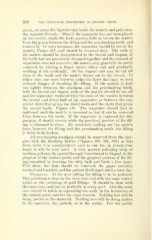Page 666 - My FlipBook
P. 666
328 THE TECHNICAL PEOCEDXJEES IN FILLING TEETH.
given, cut away the ligature that holds the matrix and pull away
the separate threads. Then if the separator has not been placed
on the matrix, strain the teeth apart a little to loosen the matrix
from the grasp between the filling and the proximating tooth, and
remove it. In most instances, the separator should be set on the
matrix, Figure 417, and should be removed first. The ends of
the matrix should be straightened to the buccal and lingual. If
the teeth had not previously dropped together and the amount of
separation was not excessive, the matrix may generally be easily
removed by placing a finger under either end and gradually
woi'king it out occlusally. Or the lingual end may be cut off
close to the tooth and the matrix drawn out to the buccal. In
either case, one must learn to judge the force that may be used
without danger of breaking the filling. If the matrix is held
too tightly between the amalgam and the proximating tooth,
both the buccal and lingual ends of the matrix should be cut off
and the separator replaced with the ends of the matrix between
the mesial and distal half of the separator, or between the sep-
arator claws that grasp the distal tooth and the claws that grasp
the mesial tooth. Figure 418. The separator should then be
tightened until the matrix is loosened so that it can be removed
from between the teeth. If the separator is replaced for this
purpose, it should remain while the proximal portion of the fill-
ing is trimmed to form. By carelessly pulling out the matrix
from between the filling and the proximating tooth, the filling
is liable to be broken.
All overlapping amalgam should be removed from the mar-
gins with the finishing knives (Figures 380, 381, 382) at this
time, while it is comparatively easy to cut, for, in twenty-four
hours it will be very hard. A very narrow polishing strip of
medium grit may be passed through from buccal to lingual, to the
gingival of the contact point, and the gingival portion of the fill-
ing smoothed by drawing the strip back and forth a few times.
This done, the dam should be removed, the gums carefully
washed and kneaded, and the patient discharged until a later day.
Polishing. At the next sitting the filling is to be polished.
This polishing is done in the same way and with the same instru-
ments as the polishing of gold fillings. It should be done with
the same care, and just as perfectly in every part. Also the same
care should be taken in separating the teeth, in the formation of
the contact point, and for the same reasons. Nothing less will be
doing justice to the material. Nothing less will be doing justice
to the operator, the patient, or to the public. For the public


